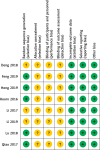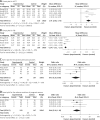Efficacy and safety of low-dose aspirin combined with low-molecular-weight heparin in treatment of preeclampsia: a meta-analysis and systematic review
- PMID: 36457979
- PMCID: PMC9710258
- DOI: 10.5114/aoms/136518
Efficacy and safety of low-dose aspirin combined with low-molecular-weight heparin in treatment of preeclampsia: a meta-analysis and systematic review
Abstract
Introduction: The role of low-dose aspirin combined with low-molecular-weight heparin (LMWH) in the treatment of preeclampsia (PE) remains unclear. We aimed to assess the efficacy and safety of low-dose aspirin combined with LMWH in PE treatment, to provide evidence for clinical PE management.
Material and methods: We searched PubMed and other databases for randomized controlled trials (RCTs) on the effects and safety of low-dose aspirin and LMWH in the treatment of PE up to January 31, 2021. Two researchers strictly followed the inclusion and exclusion criteria to independently conduct the literature screening, data extraction and quality evaluation. We used RevMan 5.3 statistical software for synthesized analysis.
Results: A total of 8 RCTs involving 861 patients were included. The synthesized outcome indicated that the differences in systolic blood pressure (MD = -10.61, 95% CI: -13.19 - -8.02), diastolic blood pressure (MD = -9.24, 95% CI: -14.49- -4.00), 24-hour urinary protein (MD = -2.24, 95% CI: -3.97- -0.50), prothrombin time (MD = 1.42, 95% CI: 0.53-2.32), activated partial thromboplastin time (MD = 2.91, 95% CI: 2.06-3.75), FIB (MD = -1.24, 95% CI: -1.32- -1.15), and adverse perinatal outcomes (MD = 0.41, 95% CI: 0.20-0.85) between the two groups were statistically significant (all p < 0.05), while the difference in the adverse reactions of pregnant women (MD = 0.44, 95% CI: 0.18-1.10) between the two groups was not statistically significant (p = 0.08). No publication bias was detected in all the synthesized outcomes (all p > 0.05).
Conclusions: Low-dose aspirin combined with LMWH treatment of PE may be advantageous to improve blood pressure, 24-hour proteinuria and coagulation function, and it may reduce the adverse reactions in pregnant women without increasing adverse perinatal outcomes.
Keywords: aspirin; dose; low-molecular-weight heparin; meta-analysis; preeclampsia; treatment.
Copyright: © 2021 Termedia & Banach.
Conflict of interest statement
The authors declare no conflict of interest.
Figures
References
-
- Rana S, Lemoine E, Granger JP, Karumanchi SA. Preeclampsia: pathophysiology, challenges, and perspectives. Circ Res 2019; 124: 1094-112. - PubMed
-
- Filipek A, Jurewicz E. Preeclampsia – a disease of pregnant women. Postepy Biochem 2018; 64: 232-29. - PubMed
-
- Auger N, Low N, Paradis G, Ayoub A, Fraser WD. Preeclampsia and the longitudinal risk of hospitalization for depression at 28 years. Soc Psychiatry Psychiatr Epidemiol 2021; 56: 429-36. - PubMed
-
- Cuckle H. Screening for early-onset preeclampsia. Am J Obstet Gynecol 2021; 224: 246. - PubMed
-
- DeCarlo C, Boitano LT, Molina RL, et al. . Pregnancy and preeclampsia are associated with acute adverse peripheral arterial events. Arterioscler Thromb Vasc Biol 2021; 41: 526-33. - PubMed
Publication types
LinkOut - more resources
Full Text Sources






